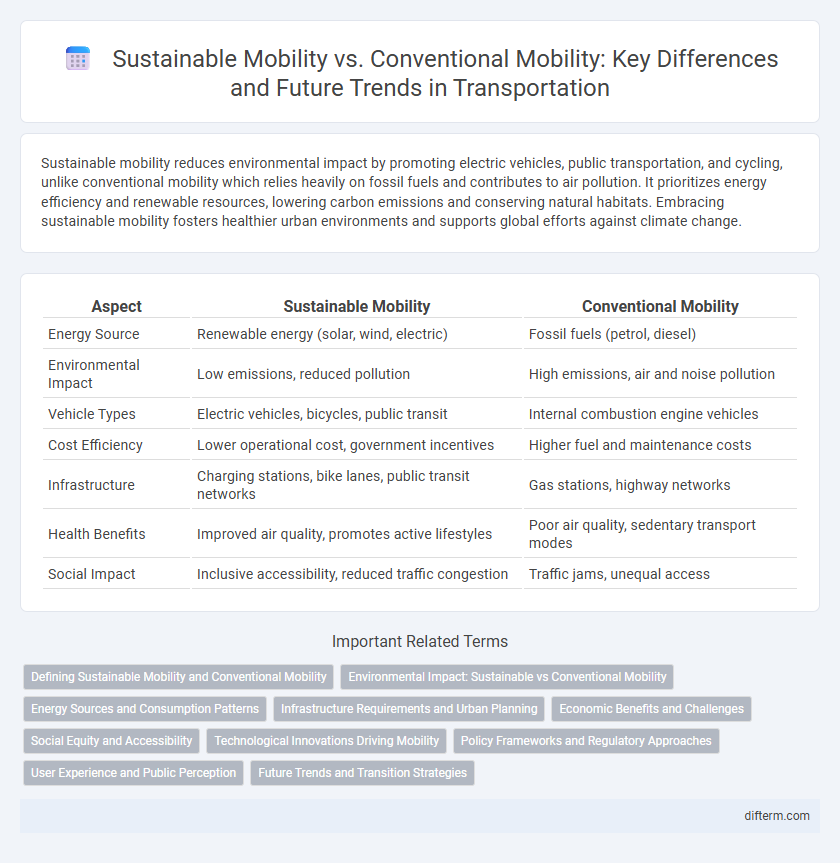Sustainable mobility reduces environmental impact by promoting electric vehicles, public transportation, and cycling, unlike conventional mobility which relies heavily on fossil fuels and contributes to air pollution. It prioritizes energy efficiency and renewable resources, lowering carbon emissions and conserving natural habitats. Embracing sustainable mobility fosters healthier urban environments and supports global efforts against climate change.
Table of Comparison
| Aspect | Sustainable Mobility | Conventional Mobility |
|---|---|---|
| Energy Source | Renewable energy (solar, wind, electric) | Fossil fuels (petrol, diesel) |
| Environmental Impact | Low emissions, reduced pollution | High emissions, air and noise pollution |
| Vehicle Types | Electric vehicles, bicycles, public transit | Internal combustion engine vehicles |
| Cost Efficiency | Lower operational cost, government incentives | Higher fuel and maintenance costs |
| Infrastructure | Charging stations, bike lanes, public transit networks | Gas stations, highway networks |
| Health Benefits | Improved air quality, promotes active lifestyles | Poor air quality, sedentary transport modes |
| Social Impact | Inclusive accessibility, reduced traffic congestion | Traffic jams, unequal access |
Defining Sustainable Mobility and Conventional Mobility
Sustainable mobility emphasizes reducing environmental impact by prioritizing low-emission transportation modes such as electric vehicles, cycling, and public transit, aiming to minimize carbon footprints and resource consumption. Conventional mobility relies heavily on internal combustion engine vehicles powered by fossil fuels, leading to higher greenhouse gas emissions and increased air pollution. The shift toward sustainable mobility integrates urban planning, energy-efficient technologies, and social equity to create accessible, eco-friendly transportation systems.
Environmental Impact: Sustainable vs Conventional Mobility
Sustainable mobility significantly reduces carbon emissions by utilizing electric vehicles, public transportation, and non-motorized travel options, decreasing reliance on fossil fuels and improving air quality. In contrast, conventional mobility depends heavily on internal combustion engines, contributing to higher greenhouse gas emissions and urban air pollution. Transitioning to sustainable mobility systems can mitigate climate change effects and promote healthier urban environments through reduced noise and pollutant levels.
Energy Sources and Consumption Patterns
Sustainable mobility primarily relies on renewable energy sources such as electricity from solar and wind, reducing dependency on fossil fuels associated with conventional mobility like gasoline and diesel. The energy consumption patterns in sustainable mobility emphasize efficiency through electric drivetrains and regenerative braking systems, significantly lowering carbon emissions. Conventional mobility often exhibits higher energy consumption and environmental impact due to internal combustion engines and reliance on non-renewable energy resources.
Infrastructure Requirements and Urban Planning
Sustainable mobility prioritizes integrated infrastructure such as dedicated bike lanes, electric vehicle charging stations, and efficient public transit routes, reducing reliance on car-centric road networks typical of conventional mobility. Urban planning in sustainable mobility emphasizes mixed-use developments and pedestrian-friendly spaces that minimize travel distances and promote low-emission transport modes. Conventional mobility infrastructure demands expansive highways and parking facilities, which often contribute to urban sprawl and increased carbon emissions.
Economic Benefits and Challenges
Sustainable mobility reduces long-term economic costs by lowering fuel expenses, decreasing healthcare costs related to pollution, and promoting energy independence through renewable resources. Conventional mobility relies heavily on fossil fuels, causing price volatility and significant environmental cleanup costs that burden economies. Transitioning to sustainable options requires upfront investments and infrastructure development, posing financial challenges for governments and businesses in the short term.
Social Equity and Accessibility
Sustainable mobility enhances social equity by providing affordable and accessible transportation options for underserved communities, reducing reliance on private vehicles and lowering transportation costs. It promotes inclusivity through expanded transit networks, pedestrian pathways, and bike lanes, improving access to jobs, education, and healthcare for all demographic groups. Conventional mobility often prioritizes car-centric infrastructure, which can marginalize low-income populations lacking vehicle ownership, thereby exacerbating social inequalities and limiting mobility options.
Technological Innovations Driving Mobility
Technological innovations such as electric drivetrains, advanced battery storage, and autonomous driving systems are accelerating the shift from conventional mobility to sustainable mobility. Sustainable mobility leverages renewable energy sources and smart infrastructure to reduce carbon emissions and improve urban air quality. Integration of IoT and AI optimizes traffic management and vehicle efficiency, positioning sustainable mobility as the future of transportation.
Policy Frameworks and Regulatory Approaches
Sustainable mobility policies emphasize low-emission vehicles, integration of public transit, and incentives for electric mobility to reduce carbon footprints and urban congestion. Regulatory approaches prioritize stringent emission standards, urban planning favoring non-motorized transport, and subsidies for renewable energy-powered infrastructure. Conventional mobility frameworks often rely on fossil fuel-based transportation, with less focus on environmental impact, limiting progress toward climate goals.
User Experience and Public Perception
Sustainable mobility enhances user experience by prioritizing comfort, accessibility, and environmental impact reduction, fostering positive public perception through cleaner air and quieter urban spaces. Conventional mobility often struggles with congestion, pollution, and noise, leading to user dissatisfaction and negative public attitudes. Integrating sustainable solutions like electric vehicles and efficient public transit improves overall quality of life and shifts public perception towards long-term urban well-being.
Future Trends and Transition Strategies
Sustainable mobility prioritizes electric vehicles, shared transportation, and investment in public transit infrastructure to reduce emissions and urban congestion. Future trends emphasize the integration of smart technology, such as AI-driven traffic management and vehicle-to-everything (V2X) communication, to enhance efficiency and safety. Transition strategies include policy incentives for clean energy adoption, urban planning focused on walkability, and the phased phase-out of fossil fuel-powered vehicles.
sustainable mobility vs conventional mobility Infographic

 difterm.com
difterm.com